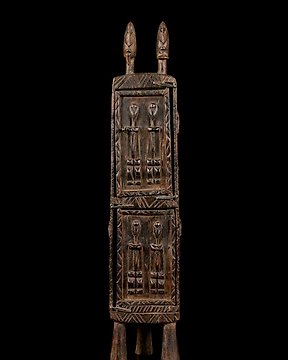
藥箱 - Dogon - 馬里 (沒有保留價)
編號 83441897

編號 83441897

A Bamana or Mianka "Boliw" (fetish), Mali, Central Segou region, in shape of a so called "Wantchi", collected in the Bla region, 80 km Eastwards on the road to Burkina Faso.
According of Brett-Smith they are "used by high ranking male members of the feared Komo association to focus power from the spirit world. The unique heavily encrusted surface on these objects is the result of a compilation of a variety of sacrificial elements such as wood, bark, tree roots, cotton, animal hair, blood and other substances applied as an offering over to the spirits, collected in the Bamana region of Bla, 120 km from Segou together with a small sack-like fetish object.
This object, called a boli (pl. boliw), once played a central role in the ritual life of a Bamana village. Such power objects are owned by male initiation associations whose members progress through induction processes that span decades. Over time, they attain esoteric knowledge that leads to a greater understanding of the natural and spiritual worlds. Opaque and mysterious to the uninitiated eye, boliw are safely handled only by those association members equipped with the most rarified skills and
expertise.
The primary function of a boli is to accumulate and control the naturally occurring life force called nyama for the spiritual benefit of the community. Used as altars or carried during dance performances, they are complex creations created from esoteric recipes, or daliluw. Animal bones, vegetable matter, honey, and metal are packed around an interior armature of bamboo.
wrapped in white cotton cloth. They are covered with layers of mud and clay, and their surfaces accumulate sacrificial materials over time, including chicken and goat blood, chewed kola nuts, alcohol, and millet porridge. Each added layer of material lends the structure greater spiritual power.
Boliw and their numerous ingredients have been interpreted in a number of different ways. It has been suggested, for instance, that the disparate elements of which boliw are composed symbolize the various parts of the universe, so that the whole can be read as a model of Bamana cosmological belief. It has also been noted that the boliw's sacrificial coatings are strikingly similar to the undigested contents of human stomachs, while the interiors of the boliw are made of materials generally associated with the body's exterior. For this reason, they have sometimes been interpreted as portrayals of animals and people turned inside out. While this example takes a vaguely bovine form, others are more representative of recognizable subjects, including human
figures.
Sources: A History of Art in Africa - The Art of A Continent.
F0r related exemplares: s. Sarah Brett-Smith, The Making of Bamana Sculpture, Creativity and Gender, Cambridge University Press, 1994; 24.
According of Brett-Smith they are "used by high ranking male members of the feared Komo association to focus power from the spirit world. The unique heavily encrusted surface on these objects is the result of a compilation of a variety of sacrificial elements such as wood, bark, tree roots, cotton, animal hair, blood and other substances applied as an offering over to the spirits, collected in the Bamana region of Bla, 120 km from Segou together with a small sack-like fetish object.
Boli (pl. boliw), once played a central role in the ritual life of a Bamana village. Such power objects are owned by male initiation associations whose members progress through induction processes that span decades. Over time, they attain esoteric knowledge that leads to a greater understanding of the natural and spiritual worlds. Opaque and mysterious to the uninitiated eye, boliw are safely handled only by those association members equipped with the most rarified skills and expertise.
The primary function of a boli is to accumulate and control the naturally occurring life force called nyama for the spiritual benefit of the community. Used as altars or carried during dance performances, they are complex creations created from esoteric recipes, or daliluw. Animal bones, vegetable matter, honey, and metal are packed around an interior armature of bamboo wrapped in white cotton cloth. They are covered with layers of mud and clay, and their surfaces accumulate sacrificial materials over time, including chicken and goat blood, chewed kola nuts, alcohol, and millet porridge. Each added layer of material lends the structure greater spiritual power.
Boliw and their numerous ingredients have been interpreted in a number of different ways. It has been suggested, for instance, that the disparate elements of which boliw are composed symbolize the various parts of the universe, so that the whole can be read as a model of Bamana cosmological belief. It has also been noted that the boliw's sacrificial coatings are strikingly similar to the undigested contents of human stomachs, while the interiors of the boliw are made of materials generally associated with the body's exterior. For this reason, they have sometimes been interpreted as portrayals of animals and people turned inside out. While this example takes a vaguely bovine form, others are more representative of recognizable subjects, including human
figures.
Sources: A History of Art in Africa and Africa and Africa - The Art of A Continent.